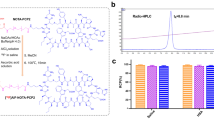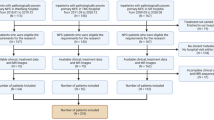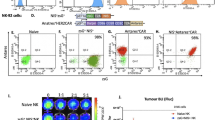Abstract
Purpose
Apoptosis may be an indication of success therapy, and precise detection of apoptosis can provide instructional suggestions in the therapy management of malignant tumors.
Procedures
We used CNE-1 cell lines for in vitro experiments, and colony formation assay, CCK-8 assay, cell apoptosis analysis, and western blotting were performed. For in vivo experiments, subcutaneous xenotransplanted tumor models of CNE-1 in nude mice were established. Then, small animal positron emission tomography/X-ray computed tomography (PET/CT) images were acquired by tail intravenous injection of 2-(5-[18F]fluoropentyl)-2-methyl-malonic acid ([18F]ML-10) or 2-deoxy-2-[18F]fluoro-d-glucose ([18F]FDG) before and 24 h and 48 h after treatment. Moreover, expression of epidermal growth factor receptor (EGFR), Ki-67, Glut-1, and terminal deoxynucleotidyl transferase-mediated dUTP nick end labeling (TUNEL) was examined by immunohistochemical examination. Tumor volumes of mice were recorded every 2 days.
Results
In the presence of Cetuximab, the number of colonies of CNE-1 cells decreased significantly after irradiation at 1 and 2 Gy. In addition, Cetuximab increased the radiation-induced cytotoxicity and apoptosis of CNE-1 cells. Mechanistic studies demonstrated that Cetuximab enhanced radiosensitivity by suppressing the EGFR/PI3-K/AKT pathway. In PET/CT imaging, the tumors showed clear uptake of [18F]ML-10 at 24 h and 48 h after combined treatment, and the value of tumor/muscle (T/M) and SUVmax (the max of standard uptake value) was significantly higher than those of the other three groups. The T/M of [18F]ML-10 uptake showed a positive correlation of 0.926 with the apoptosis index (P < 0.001). However, the uptake of [18F]FDG in tumors exhibited no trend among the four groups. The T/M of [18F]FDG revealed a positive correlation of 0.926 with Glut-1 intensity (P < 0.001).
Conclusions
Our work revealed that Cetuximab could increase the radiosensitivity of CNE-1 cells both in vitro and in vivo. Apoptosis imaging with [18F]ML-10 PET/CT is a promising modality for application in the response prediction of nasopharyngeal carcinoma.






Similar content being viewed by others
References
Torre LA, Bray F, Siegel RL, Ferlay J, Lortet-Tieulent J, Jemal A (2015) Global cancer statistics, 2012. CA Cancer J Clin 65:87–108
Chua MLK, Wee JTS, Hui EP, Chan ATC (2016) Nasopharyngeal carcinoma. Lancet 387:1012–1024
Blanchard P, Lee A, Marguet S, Leclercq J, Ng WT, Ma J, Chan AT, Huang PY, Benhamou E, Zhu G, Chua DT, Chen Y, Mai HQ, Kwong DL, Cheah SL, Moon J, Tung Y, Chi KH, Fountzilas G, Zhang L, Hui EP, Lu TX, Bourhis J, Pignon JP, MAC-NPC Collaborative Group (2015) Chemotherapy and radiotherapy in nasopharyngeal carcinoma: an update of the MAC-NPC meta-analysis. Lancet Oncol 16:645–655
Bublil EM, Yarden Y (2007) The EGF receptor family: spearheading a merger of signaling and therapeutics. Curr Opin Cell Biol 19:124–134
Zhang P, Wu SK, Wang Y et al (2015) p53, MDM2, eIF4E and EGFR expression in nasopharyngeal carcinoma and their correlation with clinicopathological characteristics and prognosis: a retrospective study. Oncol Lett 9:113–118
Chan AT, Hsu MM, Goh BC et al (2005) Multicenter, phase II study of cetuximab in combination with carboplatin in patients with recurrent or metastatic nasopharyngeal carcinoma. J Clin Oncol 23:3568–3576
Ma BB, Kam MK, Leung SF et al (2012) A phase II study of concurrent cetuximab-cisplatin and intensity-modulated radiotherapy in locoregionally advanced nasopharyngeal carcinoma. Ann Oncol 23:1287–1292
Suntharalingam M, Kwok Y, Goloubeva O, Parekh A, Taylor R, Wolf J, Zimrin A, Strome S, Ord R, Cullen KJ (2012) Phase II study evaluating the addition of cetuximab to the concurrent delivery of weekly carboplatin, paclitaxel, and daily radiotherapy for patients with locally advanced squamous cell carcinomas of the head and neck. Int J Radiat Oncol Biol Phys 82:1845–1850
Reshef A, Shirvan A, Waterhouse RN, Grimberg H, Levin G, Cohen A, Ulysse LG, Friedman G, Antoni G, Ziv I (2008) Molecular imaging of neurovascular cell death in experimental cerebral stroke by PET. J Nucl Med 49:1520–1528
(2013) Poster Presentation. J Label Compd Radiopharm 56:S88–S462. https://doi.org/10.1002/jlcr.3058
Chen QY, Wen YF, Guo L, Liu H, Huang PY, Mo HY, Li NW, Xiang YQ, Luo DH, Qiu F, Sun R, Deng MQ, Chen MY, Hua YJ, Guo X, Cao KJ, Hong MH, Qian CN, Mai HQ (2011) Concurrent chemoradiotherapy vs radiotherapy alone in stage II nasopharyngeal carcinoma: phase III randomized trial. J Natl Cancer Inst 103:1761–1770
Lee AW, Ng WT, Chan LL et al (2014) Evolution of treatment for nasopharyngeal cancer—success and setback in the intensity-modulated radiotherapy era. Radiother Oncol 110:377–384
Wu X, Huang PY, Peng PJ, Lu LX, Han F, Wu SX, Hou X, Zhao HY, Huang Y, Fang WF, Zhao YY, Xue C, Hu ZH, Zhang J, Zhang JW, Ma YX, Liang WH, Zhao C, Zhang L (2013) Long-term follow-up of a phase III study comparing radiotherapy with or without weekly oxaliplatin for locoregionally advanced nasopharyngeal carcinoma. Ann Oncol 24:2131–2136
Lee AW, Foo W, Mang O et al (2003) Changing epidemiology of nasopharyngeal carcinoma in Hong Kong over a 20-year period (1980-99): an encouraging reduction in both incidence and mortality. Int J Cancer 103:680–685
Tang LL, Chen WQ, Xue WQ, He YQ, Zheng RS, Zeng YX, Jia WH (2016) Global trends in incidence and mortality of nasopharyngeal carcinoma. Cancer Lett 374:22–30
Xu Z-X, Lin Z-X, Fang J-Y, Wu KS, du PL, Zeng Y, Tang WR, Xu XL, Lin K (2015) Mortality characteristic and prediction of nasopharyngeal carcinoma in China from 1991 to 2013. Asian Pac J Cancer Prev 16:6729–6734
Chua DTT, Nicholls JM, Sham JST, Au GKH (2004) Prognostic value of epidermal growth factor receptor expression in patients with advanced stage nasopharyngeal carcinoma treated with induction chemotherapy and radiotherapy. Int J Radiat Oncol Biol Phys 59:11–20
Ma X, Huang J, Wu X, Li X, Zhang J, Xue L, Li P, Liu L (2014) Epidermal growth factor receptor could play a prognostic role to predict the outcome of nasopharyngeal carcinoma: a meta-analysis. Cancer Biomark 14:267–277
Trivedi S, Concha-Benavente F, Srivastava RM, Jie HB, Gibson SP, Schmitt NC, Ferris RL (2015) Immune biomarkers of anti-EGFR monoclonal antibody therapy. Ann Oncol 26:40–47
Prenzel N, Fischer OM, Streit S, Hart S, Ullrich A (2001) The epidermal growth factor receptor family as a central element for cellular signal transduction and diversification. Endocr Relat Cancer 8:11–31
Bussink J, van der Kogel AJ, Kaanders JHAM (2008) Activation of the PI3-K/AKT pathway and implications for radioresistance mechanisms in head and neck cancer. Lancet Oncol 9:288–296
Gu J, Yin L, Wu J, Zhang N, Huang T, Ding K, Cao H, Xu L, He X (2016) Cetuximab and cisplatin show different combination effect in nasopharyngeal carcinoma cells lines via inactivation of EGFR/AKT signaling pathway. Biochem Res Int 2016:7016907
Stegeman H, Kaanders JH, van der Kogel AJ, Iida M, Wheeler DL, Span PN, Bussink J (2013) Predictive value of hypoxia, proliferation and tyrosine kinase receptors for EGFR-inhibition and radiotherapy sensitivity in head and neck cancer models. Radiother Oncol 106:383–389
Sung FL, Poon TCW, Hui EP et al (2005) Antitumor effect and enhancement of cytotoxic drug activity by cetuximab in nasopharyngeal carcinoma cells. In Vivo 19:237–245
Ralph W, Umar M (2001) Molecular imaging. Radiology 219:316–333
Hatt M, Majdoub M, Vallieres M et al (2014) 18F-FDG PET uptake characterization through texture analysis: investigating the complementary nature of heterogeneity and functional tumor volume in a multi-cancer site patient cohort. J Nucl Med 56:38–44
Oyama N, Miller TR, Dehdashti F et al (2003) 11C-acetate PET imaging of prostate cancer: detection of recurrent disease at PSA relapse. J Nucl Med 44:549–555
Chen W, Cloughesy T, Kamdar N, Satyamurthy N, Bergsneider M, Liau L, Mischel P, Czernin J, Phelps ME, Silverman DH (2005) Imaging proliferation in brain tumors with 18F-FLT PET: comparison with 18F-FDG. J Nucl Med 46:945–952
Linden HM, Stekhova SA, Link JM, Gralow JR, Livingston RB, Ellis GK, Petra PH, Peterson LM, Schubert EK, Dunnwald LK, Krohn KA, Mankoff DA (2006) Quantitative fluoroestradiol positron emission tomography imaging predicts response to endocrine treatment in breast cancer. J Clin Oncol 24:2793–2799
Cohen A, Shirvan A, Levin G (2009) From the Gla domain to a novel small-molecule detector of apoptosis. Cell Res 19:625–637
Hoglund J, Shirvan A, Antoni G, Gustavsson SA, Langstrom B, Ringheim A, Sorensen J, Ben-Ami M, Ziv I (2011) 18F-ML-10, a PET tracer for apoptosis: first human study. J Nucl Med 52:720–725
Oborski MJ, Laymon CM, Qian Y, Lieberman FS, Nelson AD, Mountz JM (2014) Challenges and approaches to quantitative therapy response assessment in glioblastoma multiforme using the novel apoptosis positron emission tomography tracer F-18 ML-10. Transl Oncol 7:111–119
De Saint-Hubert M, Prinsen K, Mortelmans L et al (2009) Molecular imaging of cell death. Methods 48:178–187
Neves AA, Brindle KM (2006) Assessing responses to cancer therapy using molecular imaging. Biochim Biophys Acta 1766:242–261
Oborski MJ, Laymon CM, Lieberman FS, Drappatz J, Hamilton RL, Mountz JM (2014) First use of 18F-labeled ML-10 PET to assess apoptosis change in a newly diagnosed glioblastoma multiforme patient before and early after therapy. Brain Behav 4:312–315
Shankar LK, Hoffman JM, Bacharach S, Graham MM, Karp J, Lammertsma AA, Larson S, Mankoff DA, Siegel BA, van den Abbeele A, Yap J, Sullivan D, National Cancer Institute (2006) Consensus recommendations for the use of 18F-FDG PET as an indicator of therapeutic response in patients in National Cancer Institute trials. J Nucl Med 47:1059–1066
Acknowledgements
We wish to thank Jianmin Luo for excellent technical assistances.
Funding
This study was funded by the National Natural Science Foundation of China (No. 81501503) and the Shanghai Engineering Research Center of Molecular Imaging Probes Program (No. 14DZ2251400).
Author information
Authors and Affiliations
Corresponding author
Ethics declarations
All animal experiments met guidelines evaluated and approved by the ethics committee of Fudan University.
Conflict of Interest
The authors declare that they have no conflict of interest.
Ethical Approval
All applicable institutional and/or national guidelines for the care and use of animals were followed.
Electronic Supplementary Material
ESM 1
(PDF 1004 kb)
Rights and permissions
About this article
Cite this article
Gu, B., Liu, S., Sun, Y. et al. Predictive Value of [18F]ML-10 PET/CT in Early Response Evaluation of Combination Radiotherapy with Cetuximab on Nasopharyngeal Carcinoma. Mol Imaging Biol 21, 538–548 (2019). https://doi.org/10.1007/s11307-018-1277-9
Published:
Issue Date:
DOI: https://doi.org/10.1007/s11307-018-1277-9




